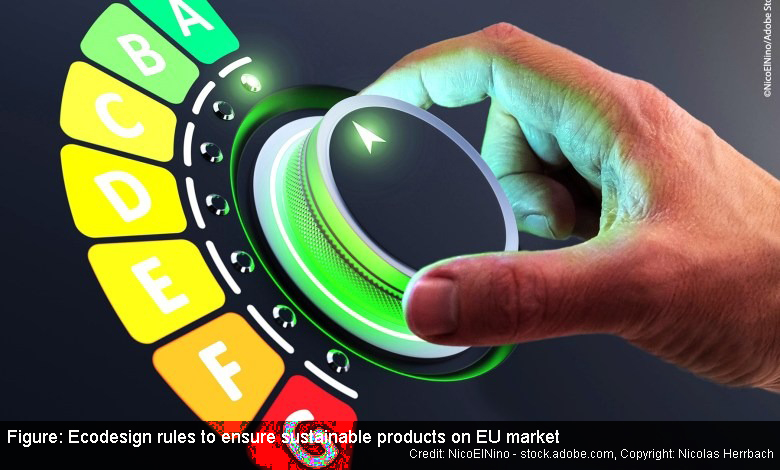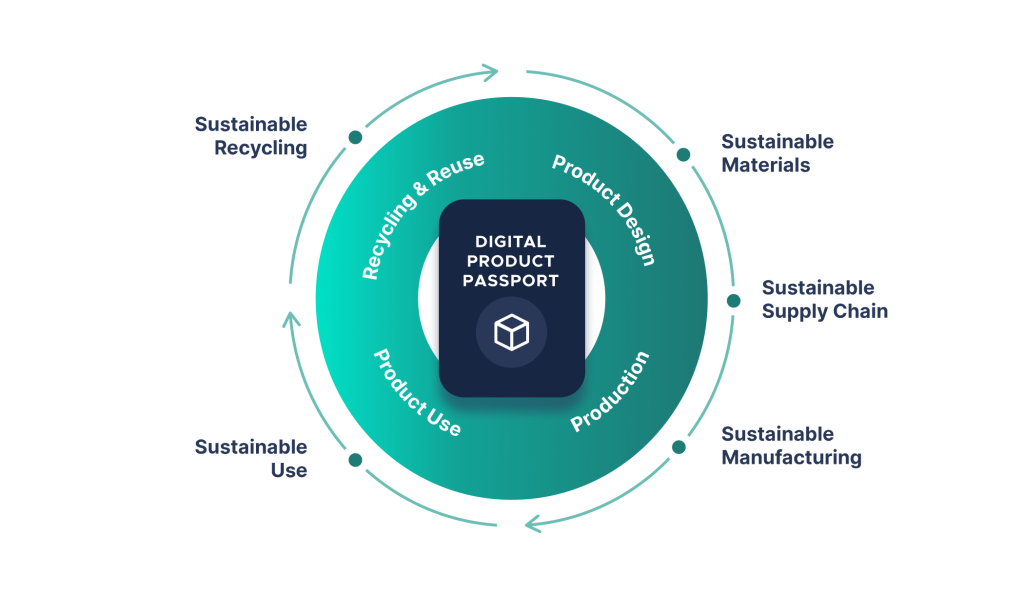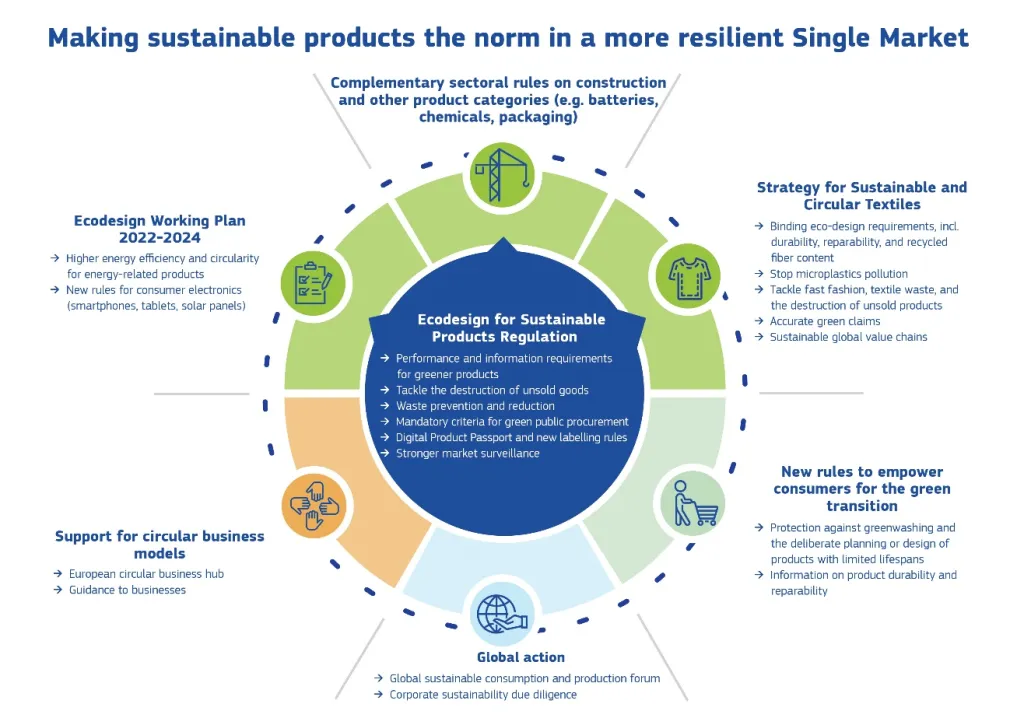
Category: SUSTAINABILITY
Country: Belgium
By M A Mohiemen Tanim
Last Updated: 25th April, 2024
The European Union (EU) has taken a significant step towards a more sustainable future with the approval of new “ecodesign” rules. These regulations aim to transform the way products are manufactured, consumed, and disposed of within the bloc, with a particular emphasis on the textile and fashion industry. This industry has long been criticized for its environmental impact, from resource depletion and pollution during production to the generation of vast amounts of textile waste.
The new ecodesign rules target the prevailing “take, make, throw away” model that dominates the fashion sector. This linear model is characterized by low-quality, inexpensive clothing designed to be quickly discarded and replaced. The environmental costs of this system are significant. The textile and fashion industry is responsible for a substantial share of global greenhouse gas emissions, water pollution, and microplastic contamination.

Figure: “take, make, throw away” model
The new EU regulations aim to address these challenges by promoting a more circular economy for textiles. A circular economy focuses on keeping products and materials in use for as long as possible. This can be achieved through a variety of strategies, including:
Design for durability and repairability: Clothes should be made from high-quality materials that can withstand wear and tear. They should also be designed to be easily repaired, so that minor damage does not necessitate discarding the garment.
Promote reusability and rental models: Encouraging consumers to rent clothing or buy second-hand clothes can extend the lifespan of garments and reduce demand for new production.
Improve recyclability: Clothes should be made from materials that can be easily recycled into new products. This will help to close the loop in the textile industry and reduce reliance on virgin resources.
The new ecodesign rules will require textile and fashion companies to implement a number of measures to achieve these goals. These measures may include:
Ecodesign requirements: The Commission will establish specific ecodesign criteria for textiles, such as minimum durability standards and requirements for the use of recycled materials.
Digital product passports: These digital documents will provide consumers with information on a garment’s environmental impact, durability, and recyclability. This will empower consumers to make more informed purchasing decisions.
Extended producer responsibility: Companies will be held financially responsible for the collection and recycling of their products at the end of their useful life. This will incentivize companies to design more sustainable products.

Figure: Digital Product Passport , © IOTA Foundation Blog
The new ecodesign rules are expected to have a significant impact on the textile and fashion industry. Companies will need to invest in new design processes, production methods, and recycling technologies. However, these changes are essential to address the industry’s environmental impact and ensure its long-term sustainability.
Benefits of the New Ecodesign Rules for the Textile & Fashion Industry
The new ecodesign rules offer several potential benefits for the textile and fashion industry, including:
Reduced costs: By designing more durable and repairable clothing, companies can reduce their production costs over time. Additionally, improved recycling rates can help to lower the cost of raw materials.
Enhanced brand reputation: Consumers are increasingly demanding sustainable products. Companies that can demonstrate their commitment to sustainability can improve their brand reputation and attract more customers.
Innovation: The new ecodesign rules will spur innovation in the textile and fashion industry. Companies will need to develop new technologies and business models to meet the new requirements. This innovation can lead to the creation of new products and services.
Challenges of Implementing the New Ecodesign Rules
The implementation of the new ecodesign rules will also present some challenges for the textile and fashion industry, including:
Increased costs: Companies will need to invest in new design processes, production methods, and recycling technologies. These investments can be significant, particularly for smaller companies.
Consumer behavior: The success of the new ecodesign rules will depend in part on changing consumer behavior. Consumers need to be willing to pay a premium for more sustainable clothing and to take care of their clothes so that they last longer.
Enforcement: The effectiveness of the new ecodesign rules will depend on robust enforcement mechanisms. Governments will need to ensure that companies are complying with the new requirements.
The EU’s Leadership in Sustainable Textiles
The EU is a global leader in promoting sustainable textiles. The new ecodesign rules are a significant step forward in this effort. These regulations are likely to be adopted by other countries in the coming years, as the world grapples with the environmental challenges posed by the textile and fashion industry.
The Impact on Consumers
Consumers will be directly affected by the new ecodesign rules in several ways:
Price: There may be a slight increase in the initial cost of clothing as companies invest in more sustainable materials and production methods. However, these costs are expected to be offset by the increased durability of garments, potentially leading to long-term savings.
Transparency: Digital product passports will provide consumers with greater transparency about the environmental impact of the clothing they purchase. This information will empower them to make informed choices that align with their values.
Availability: The availability of certain styles or trends may be limited as companies shift towards more sustainable production methods. However, this could also lead to an increase in innovation and the development of new, more sustainable fashion options.
Shifting consumer behavior: The new ecodesign rules are likely to encourage a shift towards more mindful consumption habits. Consumers may be more inclined to:
-Buy fewer, higher-quality garments.
-Repair and care for their clothes to extend their lifespan.
-Consider renting clothing or buying second-hand clothes.
-This shift in consumer behavior will be crucial for the success of the new ecodesign rules. Ultimately, the transition to a more sustainable textile and fashion industry requires a collaborative effort from both businesses and consumers.

Figure: Overview of initiatives in the EU’s Circular Economy package, © European Comission
The Future of Sustainable Textiles in the EU
The new ecodesign rules represent a turning point for the textile and fashion industry in the EU. These regulations have the potential to:
Reduce the environmental impact of the industry: By promoting durability, reusability, and recyclability, the new rules can significantly lower the industry’s footprint on the environment.
Create a more circular economy: The new regulations will help to close the loop in the textile industry, reducing reliance on virgin resources and promoting the use of recycled materials.
Drive innovation: Companies will be incentivized to develop new technologies and business models to meet the new ecodesign requirements. This innovation can lead to the creation of new, more sustainable products and services.
Set a global standard: The EU’s leadership in sustainable textiles is likely to inspire other countries to adopt similar regulations. This could have a significant impact on the global textile and fashion industry.
The road to a truly sustainable textile and fashion industry will not be easy. However, the new ecodesign rules represent a significant step in the right direction. By working together, businesses, consumers, and policymakers can create a more sustainable future for the industry.
Courtesy: Texspacetoday.com
Copyrights © 2026 GLOBAL TEXTILE SOURCE. All rights reserved.